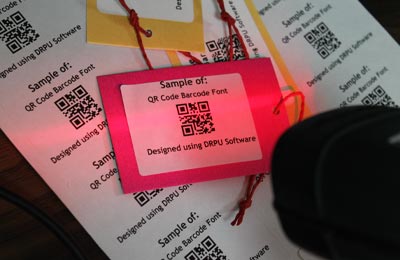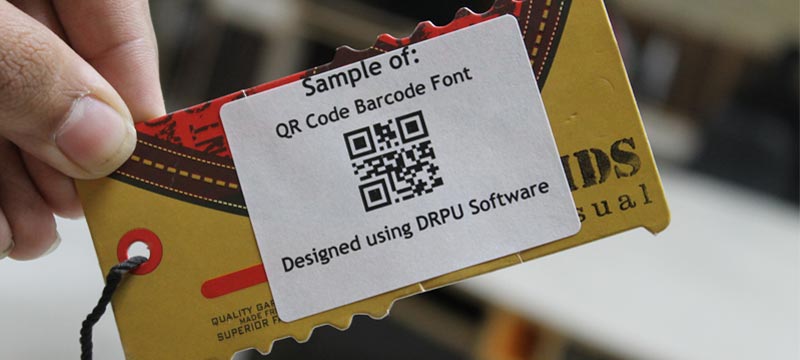Related Topics
General Steps to Decode a QR Code Barcode:
-
►
Download a QR code reader or scanner app:
There are many QR code reader or scanner apps available for download on smartphones, tablets, and computers. Some popular QR code scanner apps include QR Code Reader by Scan, QR Code Reader by Kaspersky, and QR Code Reader by Gamma Play.
-
►
Open the QR code scanner app:
Once the QR code scanner app is installed, open the app on your mobile device or computer.
-
►
Align the QR code in the camera frame:
Hold the mobile device or computer steady and align the QR code in the camera frame so that it is in focus.
-
►
Wait for the app to recognize the QR code:
The QR code scanner app will automatically recognize the QR code and decode the information.
-
►
View the decoded information:
Once the app has decoded the QR code, the information encoded in the QR code will be displayed on the mobile device or computer.
-
►
Take action based on the decoded information:
Depending on the type of information encoded in the QR code, the user can take a variety of actions, such as visiting a website, making a payment, or accessing digital content.
The Size of a QR Code Barcode
The size of a QR Code barcode can vary depending on the amount of data it contains, the error correction level, and the size of the modules or cells used to encode the data.
-
A QR code is made up of a square matrix of black and white modules or cells arranged in a grid pattern. The size of the matrix is determined by the version of the QR code, which ranges from Version 1 to Version 40. Each version has a different number of modules and can encode a different amount of data.
-
The minimum size of a QR code is Version 1, which has a matrix size of 21 x 21 modules. The maximum size is Version 40, which has a matrix size of 177 x 177 modules. In general, larger QR codes can store more data and provide a higher level of error correction, but they also require more space to print.
-
In addition to the matrix size, the size of the individual modules or cells can also affect the overall size of the QR code. The size of the modules can range from 1 to 10 units, with larger modules generally resulting in larger QR codes.
-
The size of a QR code can also be influenced by the amount of quiet zone or margin required around the code. The quiet zone is the empty space surrounding the code that ensures that it can be properly scanned by a barcode reader. The size of the quiet zone can vary depending on the type of scanner being used, but generally requires a minimum of four modules on all sides.
Overall, the size of a QR code can range from a few millimeters to several centimeters, depending on the data being encoded, the error correction level, and the printing requirements.
The Advantages of Using a QR Code Barcode
QR codes (Quick Response codes) are a type of 2D barcode that are designed to be scanned quickly and easily by mobile devices such as smartphones. They have become increasingly popular in recent years due to their many advantages, including:

-
High storage capacity:
QR codes can store much more data than traditional barcodes, up to several hundred times more depending on the amount of information encoded. This makes them particularly useful for storing large amounts of data, such as website URLs or contact information.
-
Easy to scan:
QR codes can be scanned from any direction, making them much more convenient to use than traditional barcodes, which require a certain orientation to be read. Additionally, QR codes can be scanned quickly and easily using a smartphone or other mobile device, without the need for any additional equipment.
-
Versatile:
QR codes can be used to store a wide range of data types, including text, URLs, contact information, and even multimedia content such as images and videos. This makes them a versatile tool for a variety of applications, including marketing, advertising, and information sharing.
-
High level of error correction:
QR codes are designed to be highly resilient to errors and damage, with the ability to recover data even if part of the code is obscured or damaged. This makes them particularly useful for applications where the code may be subject to wear and tear or other types of damage.
-
Trackable:
QR codes can be designed to include tracking information, allowing businesses and organizations to monitor their use and analyze user behavior. This can be particularly useful for marketing and advertising campaigns, as well as for data collection and analysis.
-
Customizable:
QR codes can be customized with different colors and designs, allowing them to be integrated into branding and marketing materials. Additionally, they can be printed at a variety of sizes, from small stickers to large billboards, making them a flexible tool for a range of applications.
-
Enhanced user experience:
By providing a convenient and quick way to access information or content, QR codes can enhance the user experience in a variety of settings, such as retail, hospitality, and education.
-
Cost-effective:
QR codes can be generated and printed at a low cost, making them a cost-effective solution for businesses and organizations looking to implement barcode technology.
Overall, the many advantages of QR codes make them a versatile and useful tool for a wide range of applications, from marketing and advertising to information sharing and beyond. As technology continues to evolve, it is likely that QR codes will continue to play an important role in the world of barcode technology and beyond.
QR Code Barcode can be Read by any Barcode Scanner
QR Code Barcodes can be read by most modern barcode scanners and mobile devices with cameras. QR Code Barcodes are designed to be read by 2D scanners and are optimized for fast and accurate scanning. The size of the QR code and the type of scanner used can affect the accuracy of the scan, but in general, QR codes are highly reliable and can be read by a wide variety of scanners.
QR codes can be read by specialized QR code scanners or by mobile devices equipped with a camera and a QR code reader app. These apps use the device's camera to capture an image of the QR code and decode the information encoded in the code. Most modern smartphones and tablets come with a built-in QR code reader app or can download one from their app store.
QR codes can also be read by some traditional barcode scanners, but the scanner must be capable of reading 2D barcodes. Some older scanners may not be able to read QR codes, so it is important to check the scanner's specifications before using it to scan QR codes.
The QR code's design allows it to be read in any orientation, making it easier for users to scan quickly and easily. Additionally, QR codes can be read at a much greater distance than traditional barcodes, making them useful in a variety of settings, including marketing and advertising.
Download and Install Barcode Label Maker
The Limitations of using a QR Code Barcodes
QR codes are a widely used type of two-dimensional barcode due to their ability to store large amounts of information in a small space. However, like any technology, there are limitations to their use. In this answer, we will explore some of the main limitations of QR codes.

-
Barcode Quality:
Poor barcode quality can lead to errors in scanning, which can affect inventory management and customer satisfaction. To address this issue, it is important to ensure that the barcodes are printed correctly and that the printer is well-maintained. It is also essential to use high-quality barcode scanners that can read barcodes even if they are damaged.
-
Scanning Distance:
One of the main limitations of QR codes is the distance from which they can be scanned. Depending on the size of the QR code and the type of scanner used, the scanning distance can vary. Generally, QR codes must be scanned from a relatively close distance, typically within a few inches to a few feet. This can limit their use in certain settings, such as outdoor advertising, where it may not be possible for someone to get close enough to the code to scan it.
-
Scan Quality:
Another limitation of QR codes is their sensitivity to scan quality. The code must be printed at a high enough resolution and with sufficient contrast to ensure that it can be accurately read by a scanner. Additionally, any damage or smudging on the code can make it difficult or impossible to scan. This can limit their use in environments where the code may be exposed to wear and tear or moisture, such as in industrial or outdoor settings.
-
Data Capacity:
While QR codes can store a large amount of data, they do have a maximum capacity. The amount of data that can be stored depends on the size of the code and the level of error correction used. However, even with high error correction, QR codes may not be able to store enough data for certain applications, such as large images or videos.
-
Compatibility:
QR codes are generally compatible with most smartphones and mobile devices, but not all devices have built-in scanners or the necessary software to read them. This can limit their use in certain settings, such as in areas with limited access to technology or in older buildings with outdated equipment.
-
Security:
QR codes are vulnerable to hacking and manipulation, which can compromise the data they contain. Malicious individuals can create fake QR codes that lead to phishing scams or install malware on a user's device. This can be particularly problematic in settings where sensitive information is stored in QR codes, such as in healthcare or financial services.
-
Aesthetic Limitations:
QR codes are often considered to be visually unappealing and can clash with the aesthetics of a design. This can limit their use in marketing or advertising campaigns where the visual appeal of the code is important.
In conclusion, QR codes have become a popular and versatile tool for storing and transmitting data. However, their use is not without limitations. Careful consideration should be given to these limitations when deciding whether QR codes are the best solution for a particular application.
